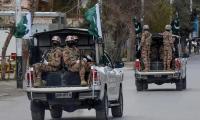The quality of air in Lahore and across many other parts of central Punjab is so bad that breathing in the outdoors feels like it’s worse than smoking two packs of cigarettes.
It is so bad that the level of toxic and harmful substances in the air is around 20-30 times higher than the limit deemed healthy by the World Health Organization and millions of people in the province are at risk of developing respiratory and/or pulmonary complications.
This hasn’t happened overnight. Lahore and much of central Punjab has been hit by smog every winter for the past few years but this time it has been particularly badly hit – so much so that the provincial government was forced to shut down schools and markets during the day, and restrict the movement of citizens to outdoor public spaces like parks, etc. It is also reportedly considering cloud seeding to produce rain artificially, since a spell of rain usually clears the air of such toxic and harmful matter.
However, all these measures are more reactive than proactive in nature. What did the Punjab government do to prevent the quality of air in Lahore and elsewhere in the province from becoming so bad? Other than continuously blame farmers in India, or the flow of air or other factors beyond its control, the Punjab government doesn’t seem to have done much proactively to improve the situation for its residents. Also blaming famers and their burning of crop residue misses the fact that the bulk of the toxic particulates in the Punjab air is being caused by vehicular pollution.
To make matters worse, the optics associated with the chief minister’s foreign visit – albeit for some medical treatment – are not good because it is inevitably going to lead to some questions being asked: why did she choose to leave the province for a trip to the West at a time when the province’s residents can barely breathe without harming their lungs and overall health, or why can’t our political leaders get treatment at medical facilities in Pakistan?
As for what needs to be done, there has to be a two-step approach. The first is how to deal with this untenable situation immediately. And then how to put in measures so that its chances of recurring are minimised.
For this, we should take a look at the recommendations put forward by the Pakistan Air Quality Experts’ Group comprising 27 concerns citizens who also happen to be experts in public health, environmental science, law and economics. They have written to Prime Minister Shehbaz Sharif to take some much-needed measures which they believe can help. These are as follows:
All brick kilns should be shut down. The group says that these are among the largest contributors to air pollution in the Punjab region and a complete shutdown would reduce emissions by 15 per cent. Of course, there is an economic angle to this which the experts’ group seems to have ignore and which the government won’t be able to – and that is that this activity is carried out by those poorer segments as a means of earning a living, and if these are shut down then they will have to shift to an alternative field, and that will not be easy.
The second step that the Pakistan Air Quality Experts’ Group want the government to take is to crack down on vehicles that do not meet emission standards, and to restrict heavy vehicles traffic on the roads from ten at night till ten the next morning. The group says that this too will lower emissions of harmful substances into the air by 15 per cent. The third step is that all industries and factories that violate the environmental standards set down by the government should be shut down and this would also reduce emissions of harmful substances by 15 per cent.
Of course, a complete closure is impractical in the real world and what the government could instead do is to raise fines and penalties and then implement these across the board on vehicles or factories that violate the emission limits. At the very least, this will provide an incentive to vehicle as well as factory owners to take measures regarding emissions that conform to the prescribed limits.
Over the longer term, the experts’ group has recommended that a monitoring network be established that is able to check air quality nationwide and in real time. This will enable collection of data in real time and would allow for better informed decision-making on the part of policymakers and that could translate into effective action and preemptive measures.
Another recommendation is that the government should prioritise developing public transport solutions that are both sustainable and use technology with low emissions. It should also work towards enhancing the capacity of its own regulatory agencies to be able to ensure emission standards are complied with and to keep violators in check by promptly penalising them. This approach will incentivise compliance.
Beyond this, a move towards use of electric vehicles and cleaner fuel should be encouraged and facilitated by the government. Furthermore, farmers in the province should be engaged and provided with solutions to residue management that don’t end up releasing toxic and harmful pollutants into the air.
The writer is a journalist based in Karachi. He tweets/posts @omar_quraishi and can be reached at: omarrquraishi@gmail.com
MPAs ask for their salaries and benefits to be at par with high court judges and exempt from tax
This system fosters and places premium on VIPs, facilitating VIP culture, which is alive and kicking
Imagine this waste covering over 15,500 cricket stadiums, piled three meters deep every year
If there is one thing that can be gleaned from politics today, it is that we no longer speak same language
Postman argues that “typographic mind” was yielding to “televisual mind”
Pakistan is well poised to meet opportunities that Artificial Intelligence will offer for developments in industries







